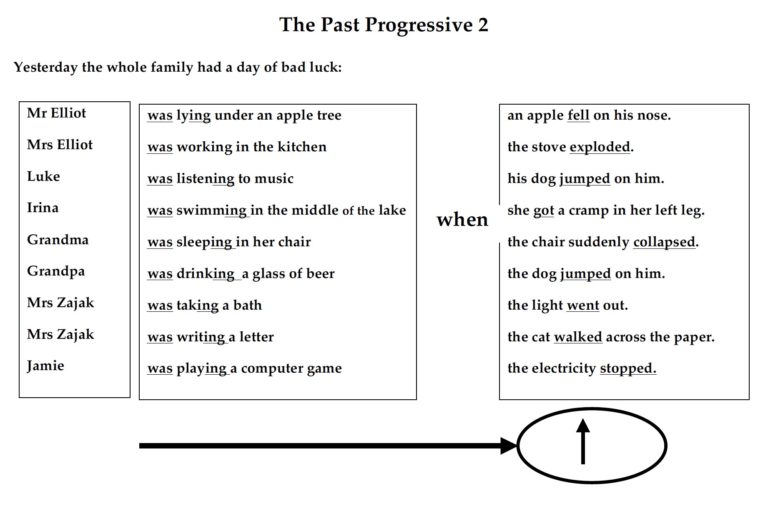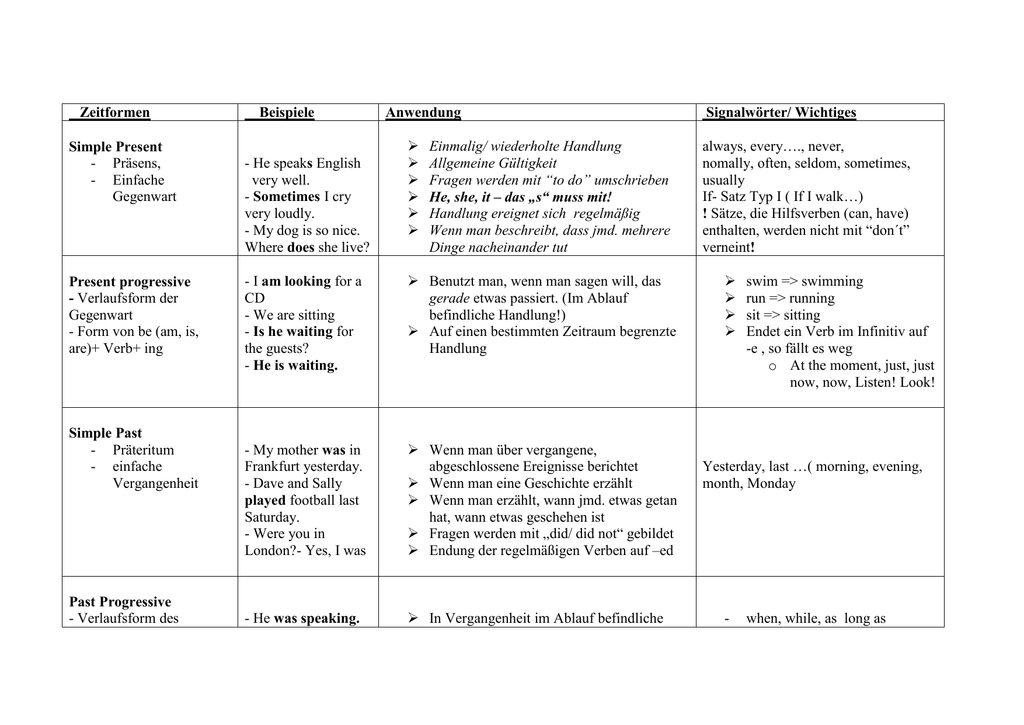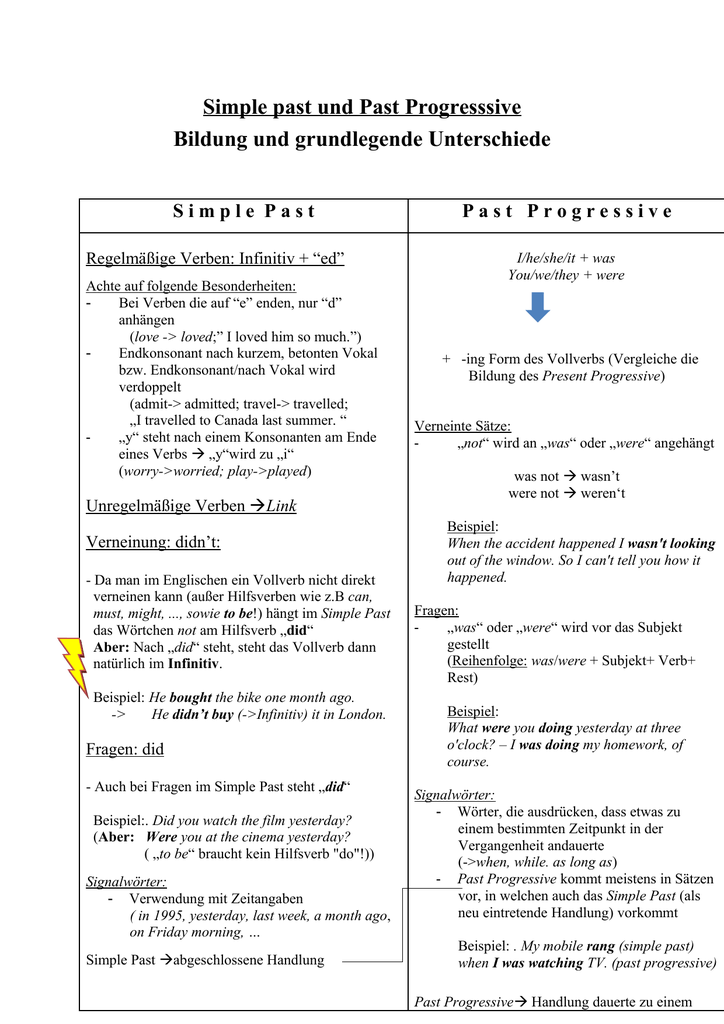
Past Perfect Progressive Bildung, Verwendung & Beispielsätze
So benutzt du das Past Progressive, wenn Ereignisse in der Vergangenheit eine Weile angedauert haben, sie also im Verlauf waren. Außerdem verwendest du es, wenn in der Vergangenheit zwei Handlungen parallel verlaufen. Ein Beispiel dafür ist, wenn du Musik hörst, während deine Mutter gerade das Essen zubereitet.

Spanish Basics How to Describe a Person’s Face Learn Spanish Englisch nachhilfe, Past
The past progressive is formed using was or were and the ing (present participle) form of the verb. Negatives in the Past Progressive (Continuous) Spelling Tip When shortening the 1st & 3rd person (I, he, she, it) negative, just remove the o in not and add an apostrophe (') was not > was n't were not > were n't

Past Progressive Bildung, Verwendung & Beispielsätze
Here are three common uses of the past progressive tense: (1) The past progressive tense can be used to describe an activity in the past that was interrupted: He was painting the door when a bird struck the window. They were sleeping when the alarm went off. (2) The past progressive tense can be used for describing an action taking place when.

Past Progressive_2 Bruce Engel
Use of Past Progressive. puts emphasis on the course of an action in the past. Example: He was playing football. two actions happening at the same time (in the past) Example: While she was preparing dinner, he was washing the dishes. action going on at a certain time in the past. Example: When I was having breakfast, the phone suddenly rang.

Past Perfect Progressive Bildung, Verwendung & Beispielsätze
Das Past Progressive ist eine Zeitform im Englischen, die im Deutschen nicht existiert. Mit dem Past Progressive drückt man im Englischen eine Handlung aus, die in der Vergangenheit fortdauert. Beispiel: While we were climbing the mountain, it started raining. Es begann (auf einmal) zu regnen, während wir (die ganze Zeit) auf den Berg kletterten.

Beispielsatz Present Perfect Hot Sex Picture
Past progressive - Einführung. Das past progressive ist eine englische Vergangenheitsform, die eine Handlung in der Vergangenheit beschreibt, die länger andauerte oder sich im Hintergrund abspielte. Die Bildung ist einfach: to be (simple past) + present participle. Signalwörter gibt es keine festen, oft wird jedoch while oder when genutzt.

Lista 96+ Imagen De Fondo Ejercicios De Past Simple Y Past Continuous Para Imprimir Mirada Tensa
Die englische Zeitform Past Progressive ist die Verlaufsform der Vergangenheit. Wir verwenden sie in folgenden Fällen: Lucy was sitting on the beach at six o'clock yesterday. Gestern um sechs saß Lucy am Strand. While Lucy was relaxing on the beach, Laurence was sailing. Während/In der Zeit als Lucy sich am Strand erholte, segelte Laurence.

Stimmen diese Sätze die ich entweder in simple past oder past progressive geschrieben habe
Das Past Progressive kannst Du auch Past Continuous nennen. Es ist eine der englischen Verlaufsformen. Sieh Dir zuerst dieses Beispiel im englischen Past Progressive an: Inhalt von Fachexperten überprüft Kostenlose StudySmarter App mit über 20 Millionen Studierenden Entdecke über 50 Millionen kostenlose Lernmaterialien in unserer App.

Past Perfect Progressive Tense Present perfect, English grammar, English vocabulary
Past Progressive / Past Continuous. Verlaufsform des Präteritum, Verlaufsform der Vergangenheit. Die Verlaufsform der Vergangenheit existiert im Deutschen nicht. Im Englischen wird mit dieser Zeitform der Ablauf einer Handlung in der Vergangenheit betont.
Past Progressive (wird auch "Past Continuous" genannt)
1. Use of the Past Progressive 1.1. actions were in progress at a special time in the past Peter was reading a book yesterday evening. 1.2. two actions were happening at the same time (the actions do not influence each other) Anne was writing a letter while Steve was reading the New York Times. 1.3. together with Simple Past

Zeitformen Beispiele Anwendung Signalwörter/ Wichtiges Simple
Das Past Progressive (auch: Past Continuous) ist eine englische Zeitform der Vergangenheit. Wie bildet man das Past Progressive und wann wird es gebraucht? Das erfährst du hier und in unserem Video ! Inhaltsübersicht Past Progressive - Bildung & Beispiele zur Stelle im Video springen (00:14)

Simple Past Past Progressive Erklärung
Eine Verneinung wird mit der Struktur gebildet, die du bereits kennst: Setze das Adverb „not" hinter „was/were": was + not = wasn't; were + not = weren't. Zum Beispiel: She wasn't listening to me when I tried to warn her. (Sie hat mir nicht zugehört, als ich sie gewarnt habe.) My brothers weren't playing games.

Residential » Amira Contracting Inc
Past Progressive 1. Verwendung des Past Progressive / Past Continuous 1.1. Handlungen dauerten zu einem bestimmten Zeitpunkt der Vergangenheit an (waren im Verlauf) Peter was reading a book yesterday evening. (Peter las gestern Abend ein Buch. - Peter war dabei, das Buch zu lesen.)

Past Progressive Tense in English Grammar YouTube
Das Past Progressive kommt oft in Sätzen vor, in denen auch das Simple Past steht. Meistens sind dabei folgende Signalwörter zu finden: while (während) → In diesem Satzteil steht meist das Past Progressive. While we were watching TV, Andy was surfing the internet. when (als) → In diesem Satzteil steht meist das Simple Past.

Simple Past auf Deutsch erklärt YouTube
The past progressive tense is a verb form used to refer to an action that was ongoing at a time in the past. The past progressive is formed using the past tense of the auxiliary verb "be" (i.e., "was/were") along with the present participle ("ing" form) of a main verb (e.g., "I was thinking"). Instantly correct all language mistakes in your text

Simple Past Bildung, Verwendung & Beispielsätze
The past progressive tense, also called the past continuous tense, emphasises a continuing or incomplete action in the past. We can use this tense to describe what was in progress at a specific moment in time in the past. It is formed with the past form of the auxiliary verb be (was/were), and the present participle or -ing form of the main verb.